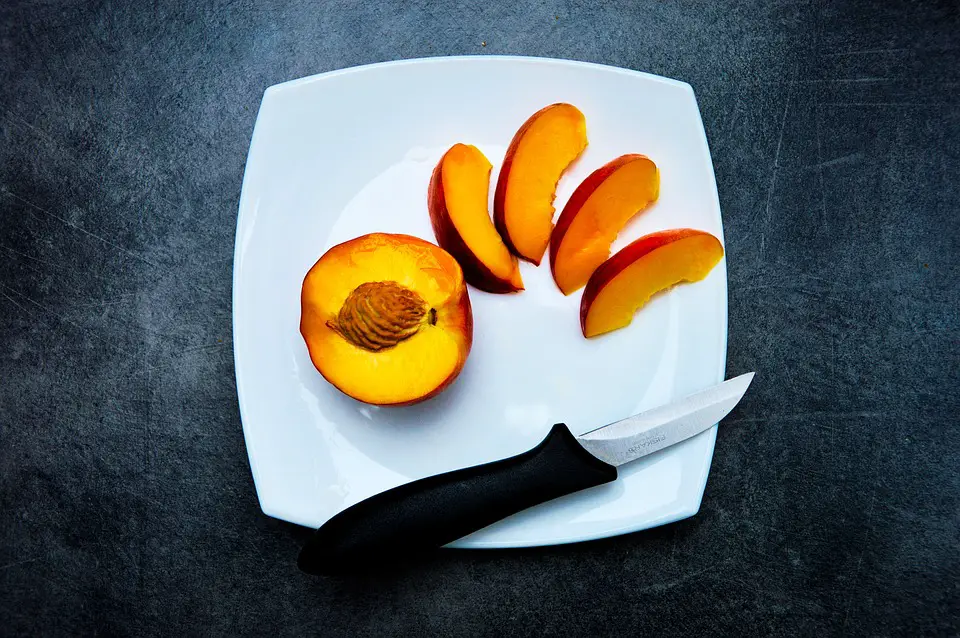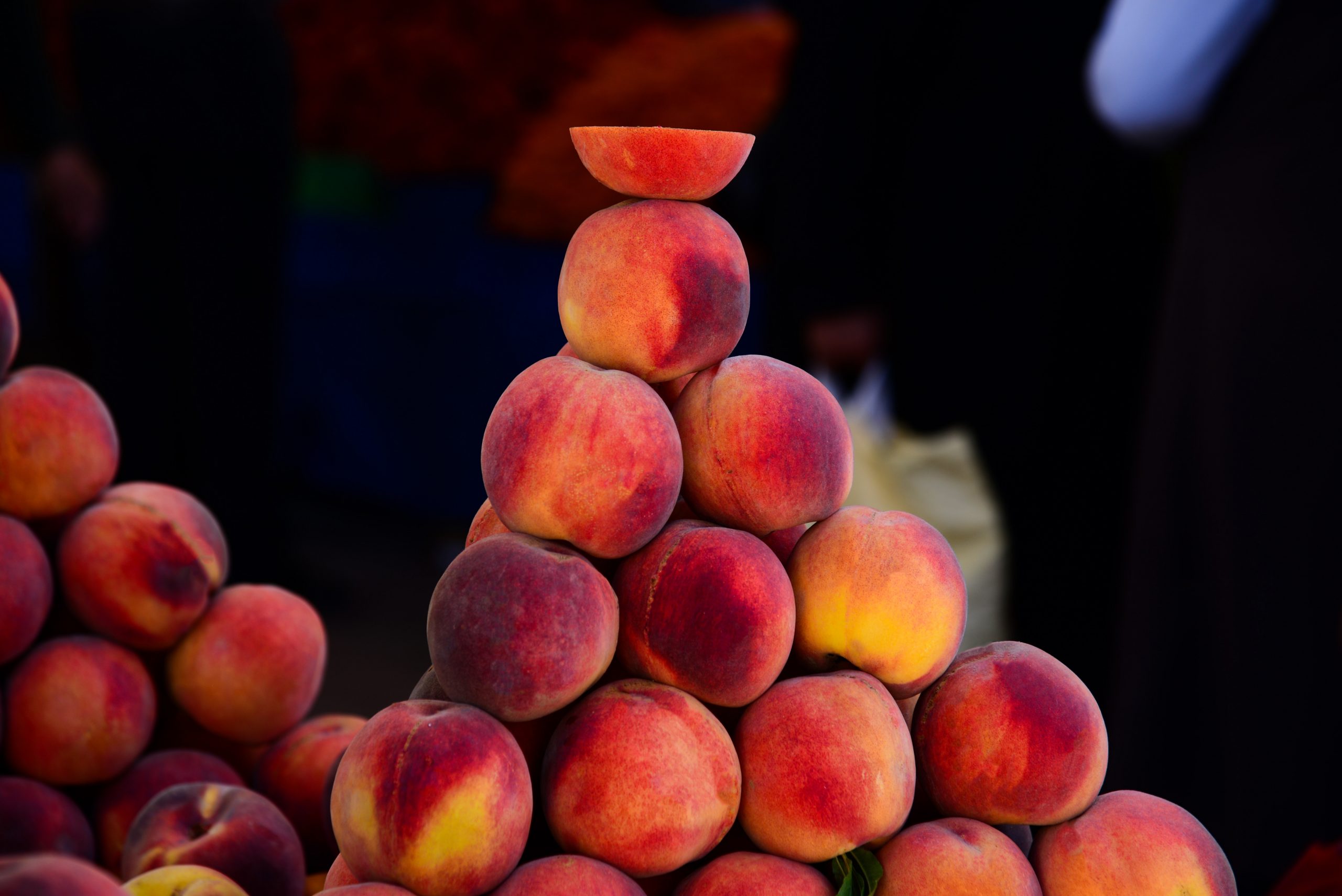If you want to know how to freeze peaches, you have come to the right place. These tasty fruits can be frozen for up to a year. Before freezing, be sure to wash the peaches and dry them thoroughly. If the peaches have skin, remove them before freezing them. This will help prevent browning.

There are several recipes in cookbooks and online for freezing peaches in sugar or syrup, but there is a simpler solution for those who want plain frozen peaches to bake into pies or blend into a morning smoothie bowl. Here is a simple guide on peeling, pitting, cutting, and preparing peaches for freezing. Use ripe peaches for the best results.
How to Choose the Best Peach for Freezing?
Selecting fruit during peak season is the best approach to freeze peaches that will taste well in the future. Peaches should be freestone, aromatic, and, ideally, ripe.
How the fruit clings to the pit distinguishes a freestone peach from a clingstone peach. Clingstone peaches stick to the fruit’s pit, as the name implies, making it more challenging to remove. Freestone peaches can be frozen and cut into slices more easily.
Understanding how to select the best fruit is the first step in learning how to freeze peaches. Always select fruit at the height of maturity when freezing peaches. Peaches should have a strong aroma and give gentle pressure at the stem end when they are fully ripe.
Additional advice for picking the ideal fruit to freeze peaches:
- Shoppers can look for tree-ripened peaches at nearby farm stands and farmers’ markets. Frequently, commercial peaches are plucked before they are fully ripe. While home ripening might alter their texture, the flavour won’t be enhanced.
- Clingstone peaches begin in mid-June, and freestone peaches can be found from late July to September. Clingstones, as their name suggests, are more challenging to pit and slice. In comparison to freestone, clingstone is typically juicier and sweeter.
- Remember that you’ll need 2 to 3 pounds of fruit for every quart of peaches you plan to freeze in a water or syrup pack. You can use any quantity of peaches that will fit your freezer to flash-freeze them.
How to Freeze Peaches?
Fresh Peach Freezing Instructions
Pitch freezing can be done in several methods (described below), but this is the tried-and-true approach. Using these peach-freezing techniques will yield the greatest results.
Step 1: Is to slice and peel the peaches.
Peeling and slicing your peaches is crucial for the best freeze.
Before slicing, blanch the peaches in hot water to make it easier to remove the skin. To lessen natural browning, combine one pound of peeled, sliced peaches with one tablespoon of fresh lemon juice.
More than a pound of peaches must be frozen. Just adhere to the pound-to-teaspoon ratio.
Step 2: Freeze the slices.
On a baking sheet covered with parchment paper, arrange the peaches in a single layer. Overnight or for around four hours, freeze until solid.
Putting all the peaches in a zip-top freezer bag would cling together and form a large (albeit still delicious) mass, so you must thaw the entire bag at once. You may easily remove as many slices as you need for a dish by freezing them in small batches.
Step 3: Place the peaches inside a zip-top freezer bag.
Transfer the frozen peach slices to a zip-top freezer bag made of plastic, squeezing out as much air as you can before sealing the bag. This will keep those slices fresh when you’re in the mood for a warm and comforting peach cobbler or a fresh peach pie in the middle of winter.
Additional Peach Freezing Methods
Flash Freeze Peaches
Peaches can be flash-frozen if you intend to utilize them within the following few months. This can be an excellent technique to preserve peaches for a little longer than the regular season. However, they won’t stay as long as peaches packed in syrup or lemon juice.
- Peaches should be washed, peeled, and pits removed.
- Peaches are cut into slices and placed on a baking pan. Cover the baking sheet with foil or parchment paper to make removing it simpler. (Also, allow space between peach slices to prevent fusion.)
- Place baking sheet in the freezer for three hours or until peaches are solid.
- Peaches should be removed and put in an airtight container. For up to two months, keep frozen.
Freeze Peaches with Syrup or Water
- Use cool water to wash peaches. Clean off. To allow for expansion, cut a tiny hole in the bottom of the peach.
- Blanch peaches by putting them in freezing water first, then hot water.
- Peel the peaches and gently remove the pits with a knife.
- Add your preferred preserves after slicing the peaches as desired.
Peaches can be frozen for up to ten months after added to sugar, water, or syrup.
Using a Glass Food Storage Container Instead of a Zip-Top Freezer Bag
A zip-top freezer bag is great for freezing peaches, but there are several benefits to using a glass food storage container. The first is that you can squeeze the air out more easily. A glass food storage container is also reusable and can last for years. Another advantage is that it can be cleaned in the dishwasher.
Second, a glass food storage container keeps the peaches fresher for longer. It’s also more durable than zip-top bags, which means it will last longer in the freezer. These containers are available in various sizes, from a pint to a gallon. You can also use them for other storage purposes.
Using Freestone or Clingstone Peaches for Freezing
If you’re planning to freeze peaches, you might wonder whether to use freestone or clingstone peaches. Both varieties are sweet and delicious, but each has advantages and disadvantages. First, the freestone variety is easier to prepare than the clingstone type. They are also larger and firmer, making them perfect for baking and freezing.
Freestone peaches are available starting mid-June, while clingstone peaches are available later in the season. Clingstones are sweeter and easier to slice, but they tend to be more difficult to freeze. Also, clingstone peaches require more work in preparation. To make the freezing process easier, remove the skins from the fruit. This will help minimize any browning.
Should I Peel Peaches Before Freezing them?
SupposeSmoothie recipes benefit greatly from using peaches with skin. You want to use your peaches in a dish where the skins need to be removed; peeling them before freezing can help. But if you don’t mind (or even like) the fuzzy peach peel, cut your cleaned and dried peaches in their half or into slices, combine them with lemon juice, and freeze them on a baking sheet coated with parchment paper before transferring them to a ziplock freezer bag.
Can Entire Peaches be Frozen?
Before putting your vegetables in a zip-top freezer bag, simply wash and dry them. Simply freeze whole peaches with their skins instead of peeling and slicing them. It’s that easy.
Run the frozen peaches under lukewarm water when you’re ready to enjoy a big bite of summer, and then use your hands to remove the skin (fuzz lovers can skip this step). Once it has thawed in the refrigerator or on the counter, you’ll have a tasty reminder of the upcoming peach season.
How to Use Frozen Peaches?
Frozen peaches can be used in so many different ways! Here are some suggestions:
- Smoothies don’t require peeled peaches, so don’t stress about it! Simply place the frozen peach slices in a high-powered blender and your preferred smoothie ingredients for a cool snack. Attempt my smooth peach smoothie.
- Oatmeal with peaches – add it to hot oatmeal or overnight oats!
- Peach jam: I’m already daydreaming about making peach jam this fall and winter. 1 1/2 cups of frozen peaches and 1 Tablespoon of coconut sugar should be added to a skillet and simmered while the peaches are broken up.
- Wanting peach crisp during the off-season? No issues this year! Here is my go-to recipe for peach crisp.
- Pour a few frozen peaches into a glass of white wine or create a delightful peach cocktail to add to wine or drinks.
Reference: Sugars in peach fruit: a breeding perspective
Selecting features related to fruit appearance and textural attributes has traditionally been the main goal of breeding projects for peaches and nectarine (Prunus persica L.). Size, colour, and firmness of the fruit are important factors for merchants since they make peaches appealing to customers, resistant to postharvest treatment, and able to have a longer shelf life. 2 Despite the tremendous advancements made through the breeding of these traits and the abundance of recently released cultivars, a general decline in peach consumption is seen in the USA and other European nations in recent decades. 3 Poor or inconsistent flavour quality has frequently been identified as the main barrier to consumer acceptability, moving preferences toward other fruit varieties with stronger flavours.
Tips for Thawing Frozen Peaches
Your peaches have been frozen, but what happens when it’s time to use them? I discovered that many recipes (like my peach smoothie recipe) call for frozen peaches, but if you need thawed peaches for a recipe, you have a few options!
The frozen peaches can also be defrosted in the refrigerator. The frozen peaches you want to thaw should be placed in a dish and left in the refrigerator until they defrost. You can use a water bath to fast defrost your peaches if you need to. Simply place the frozen peaches in a sealed bag and place the bag in a sink of cool water. Check the fruit and change the water occasionally until the peaches have defrosted.
Do Frozen Peaches Get Mushy?
Frozen peaches become mushy after being in the freezer, as other perishable fruits do. This is particularly true when they are inadequately thawed. This is what? Avoid letting frozen peaches defrost on the counter if you intend to eat them straight from the freezer since they will become mushy and unpalatable.
What Caused the Browning of my Frozen Peaches?
Why Do Peaches Turn Brown? Peach can be consumed after being washed. However, it is practically hard to stop peaches from becoming brown if you are slicing, freezing, or canning them. When you cut a peach, a group of enzymes called polyphenol oxidases (PPOs) are activated, which starts the browning process.
Conclusion
Once you understand How to Freeze Peaches, you may create mouthwatering dishes all year long, even after the peach season has ended. By simply placing them in a freezer-safe bag, peaches that have been peeled, sliced, or are still whole can be quickly and easily preserved. For the finest flavour, incorporate this fresh fruit all year long into your preferred cobbler, pie, or smoothie.
